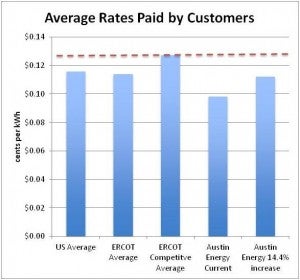Austin Energy’s Electric Rates Are Lower Than The Texas Public Policy Foundation Would Have You Believe
Austin Energy’s Residential Rates: 12% Below the Average Rate in ERCOT’s Competitive Markets – After Accounting for the Proposed 14.4% Rate Increase
Austin Energy has been in the news a lot lately, and most often for some controversy around the ongoing rate review process. What often gets lost in these heated discussions is that fact that Austin’s heritage of clean energy and innovative approaches to economic development are firmly rooted in our city’s electric utility, and that the utility allows city leaders to keep taxes low. At the same time, Austin Energy’s leadership often puts it in the crosshairs of groups that are ideologically opposed to clean energy and city owned utilities, and whether supported by facts or not, the opportunity to criticize Austin Energy has proven too difficult to resist.

The Texas Public Policy Foundation (TPPF) is often one of the ringleaders in the crusade against clean energy as well as city owned utilities, and they’re not going to let facts get in the way of scoring an ideological point. In knocking Austin Energy and promoting their agenda, TPPF cherry picks data and uses coded language like the idea that customers “can choose” rates lower than Austin Energy’s if they are in the competitive regions of the Electric Reliability Council of Texas (ERCOT). The truth is, for a customer in the competitive areas of ERCOT to maintain lower rates than Austin Energy they would have to change electric providers each month, and they’d have to be pretty lucky on top of it.
The problem is that the rates TPPF reference when they say customers can choose lower rates are usually introductory, variable or otherwise subject to increases not included in the rates that customers do choose. What this means is that customers actually pay more than TPPF’s selective math would suggest, but TPPF seems more concerned with scoring political points than what customers actually pay for their electricity.
Look at the data from a more logical point of view and you will see that competitive regions in ERCOT average higher residential rates than ERCOT’s average rates. In fact, ERCOT rates are kept low largely by municipal and co-operative utilities like Austin Energy, the customer owned utility model that TPPF criticizes in their latest missive. The most recent data available for a real analysis of the rates Texans pay was released by the Energy Information Administration just a few months ago, including data through 2010. As the chart below shows, Austin Energy’s rates are well below the ERCOT average, and even farther below the average competitive market rate, despite TPPF’s claims to the contrary.

Even if you account for Austin’s proposed 14.4% residential rate increase through 2015, the the new rates are 12% below current competitive rates in ERCOT. This calculation doesn’t even take into account the fact that nominal retail energy prices in ERCOT are projected to go up by 11% by 2015 according to the Energy Information Administration. Taking this projected rate increase into account it’s clear that Austin Energy’s rates – even after the rate review is completed – will be below the competitive average.
As we talk about rates in our community and across Texas, it’s important to remain focused on factual analysis and avoid misleading assumptions driven more by ideology than a desire for real debate. Unfortunately, arguments like those put forward by TPPF don’t contribute to an honest discourse; they mislead the public, distort reality, and threaten Austinite’s low tax lifestyle.











6 Comments
Is the chart for just residential customers or for all customers? To be meaningful, it would have to be for all customers. A comparison of only residential rates would be biased in favor of Austin Energy, because under Austin Energy’s current rates residential customers are subsidized by business customers.
Analysis of the 2010 data from the Energy Information Administration reveals that in that year, the average Austin Energy residential customer used 16% less electricity than the average Texas residential customer. That meant the average Austin Energy residential customer paid 25%, or $32 per month LESS than the average Texas residential customer–the vast majority of whom were customers of the 2 largest retail providers, TXU and Reliant. If all the customers of the top 27 providers had been Austin Energy customers in 2010 (impossible, but interesting), they would have saved some $4.5 billion in that year alone!
According to the PUC’s Electric Choice Website (powertochoose), if I lived in Georgetown, which is in the ERCOT competitive market, I could get a three-year, fixed-price plan for 9.6 cents per kWh, that’s opposed to the 10.2 cents per kWh I will be paying in Austin Energy. And that’s just for year one. It will, of course, go up again in the second increase that’s part of this plan. You may say the difference is only a few pennies, but based on my usage last year, that few pennies would have saved me about $750. That’s real money!
Thanks for the thoughtful comments everyone! Steve, you make a good point, however the TPPF analysis only looks at residential rates, hence my focus on residential rates. You might argue that C&I rates in Austin are higher than the statewide average, but then Texas C&I rates are far lower, and residential rates far higher than the national average. Which could also indicate that as a state Texas residential ratepayers are subsidizing C&I rates, and that Austin Energy’s approach is more on par with the national approach. Lots of different ways to look at these numbers.
Rufus, I assume you’re talking about the Southwest Power & Light rate. When you look at it in the spreadsheet, it actually starts out at 10¢, and at your average usage your savings would be closer to $488; as with many things, the devil is in the details. Also, Georgetown doesn’t make sense as a comparison point: Austin is a big city now, and Houston or Dallas would be better. For instance a similar rate in Houston would start at 12.9¢ and go down to 10.4¢ after 500 kWh. That would end up costing you $400 compared to the Austin Energy rate. What really matters is not what Texans could pay if you lived in Houston or Georgetown and if, in theory you found the lowest rate possible for each month (as TPPF would have it). What matters is what Texans do pay, and the numbers show that in Austin, they will continue to pay less than they do in the competitive markets in Texas.
Thanks again for the great comments, I wish we could have more thoughtful policy discussions like this in Texas, even if we’re not in agreement!
Most folks understand that public power provides longer term stable rates (instead of variable pricing). However, you neglected to mention that the real increase for residential ratepayers is more like 20% because of sweetheart contracts expiring in 2015 that Austin Energy gave to it biggest customers. AE’s plan is flawed in that it discourages conservation by having high customer fees, and because it fails to address the most vulnerable households who require and receive basic food and nutrition support through food stamps.
AE’s failure to update its Customer Assistance Program is shameful. We have heard NO testimony at City Hall from EDF on assistance for vulnerable customers. Food stamp eligibility and automatic enrollment have been in effect for years in competitive service areas. Hopefully, City leaders will get it right.
Steve, if you look at page 19 of Austin Energy’s Draft 2010 Annual Performance Report published November of 2011, they reproduce a graphic from Form EIA-861 which is 2009 data comparing industrial rates. AE’s are some of the lowest in the state at 5.89 cents/kwh.
It is also not necessarily true that C&I is subsidizing residential. There are different ways to calculate cost of service. AE made the political choice to use the AED methodology to appease high load factor C&I customers. They could have chosen a myriad of other methods including 4CP, 12CP or BIP which produce different results.
AE’s cost of service methodology is flawed. An example of how its flawed is how it treats low load factor worship facilities. These customers primarily use non-coincident peak power, however, the AED methodology grossly inflated their cost of service (thus reducing the cost of service for other C&I customers) by making the erroneous assumption that their non-coincident peaks equated the system peak.
Thanks Karl for all your great work! Energy Efficiency is so much cheaper than building new generation.
Thanks, Colin for such a great article!